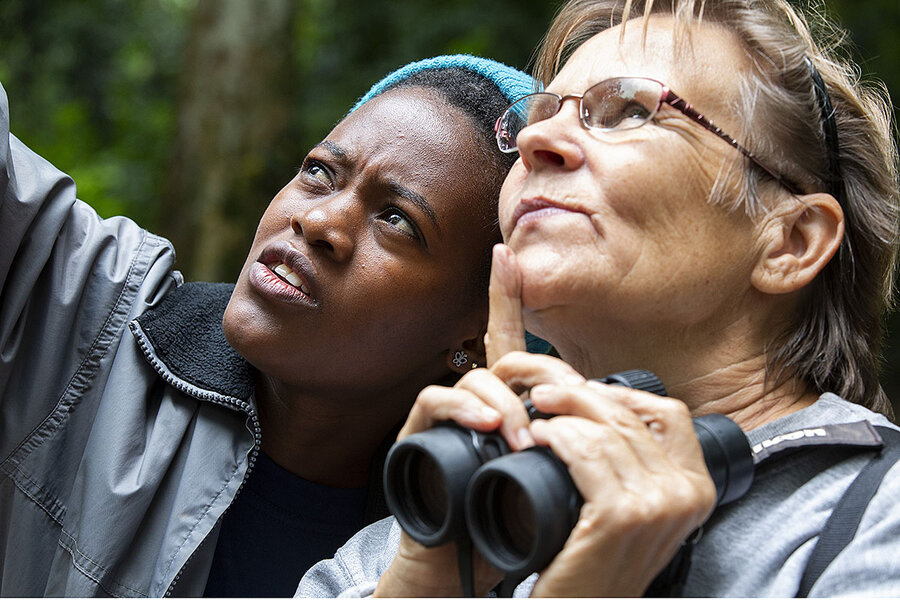With patience and binoculars, Ugandan women build jobs as birders
Loading...
| Mabira Forest, Uganda
A slight figure stepping lightly through the rainforest, Abia Atukwatse chirrups and cheeps. Sometimes she hoots and coos. Or she whoops and whistles. Then she stops and keeps her eyes peeled.
Ms. Atukwatse is a birder. But not just any kind of birder. She belongs to the all-female Uganda Women Birders group. And in Mabira Forest’s world-renowned birders’ paradise, she says, women do bird guiding differently.
“Ladies naturally pay more attention than men,” says Ms. Atukwatse. “I’m cautious and I feel I see more things.”
Why We Wrote This
Women birders in Uganda spotted an opportunity to rely on their own expertise. “We encourage women to be independent,” says a guide.
Her client today, a Swedish ecotourist called Annika Lindqvist, seems to agree.
“She has good eyes,” Ms. Lindqvist says, but there is more to it than that.
“Male guides have shown me good birds, but that’s it,” she explains. “They have a tendency to just check off the birds. Here we discuss the birds, their colors, and their behavior. I learn more.”
And there is a lot to learn. Ms. Atukwatse gives me my first lesson as I stroll ahead of her through the cool aqueous green of the forest. “Your speed is not for birders,” she admonishes me. I slow down.
Ms. Lindqvist is an avid student with a broad taste in wildlife who stops to photograph anything that moves.
“I do anything that comes my way,” she says, stooping to snap a tiny spider and then spotting an iridescent wasp on a nearby leaf. “Look, it’s really cool; it’s got spikes on it.”
Uganda Women Birders is the brainchild of Judith Mirembe, a professional birding guide frustrated that the field of ornithology – like Ugandan society as a whole – is so male-dominated.
She founded the group six years ago “to increase the number of women in nature guiding,” she explains.
“Tourism is a growing sector and it could give women a way to earn a livelihood and support their families” in a country where the unemployment rate is twice as high for women as it is for men. “Also we encourage women to be independent,” Ms. Mirembe adds.
But she recognized that birding is an expensive occupation requiring binoculars, laser pointers (to direct clients’ attention to the right bit of the right tree), and field guides. As a group, members could share equipment and experienced birders could teach new ones. Uganda Women Birders now comprises 60 members, including 30 active guides earning their living from the business.
Ms. Atukwatse was an intern at a Ugandan gorilla park when she “saw some other ladies birding around and they introduced me to the activity.” She was intrigued by the group’s approach.
“I felt as if I was easily understood because we see things from the same perspective as females – for example the need to make our own living,” she recalls.
Plus, she adds, “most ladies love color. I ended up loving birds because they are colorful.” Ms. Atukwatse herself sports an eye-catching turquoise watch cap.
The birder says she can now recognize 800 of the 1,061 bird species found in Uganda and mimic the calls of nearly 400 – “and I’m still learning.”
Ms. Lindqvist came across her guide on the World Girl Birders Facebook group. “I thought it would be a nice change to have a female guide and a good way to support women who are not really in the workplace in Uganda,” she says.
With Ms. Atukwatse’s help, Ms. Lindqvist spots lots of birds, and notes them all down like a competitive birder. I have less luck as an absolute novice, focusing my binoculars repeatedly on leaves fluttering in the wake of a bird’s departure.
And then Ms. Atukwatse directs me to two extraordinary birds high in the forest canopy with massive box-shaped beaks. They are a beginner birder’s ideal target, so enormous as to be unmissable, sitting absolutely motionless, superbly indifferent to my presence.
Black-and-white-casqued hornbills, she tells me. (It’s worth Googling them.) I stare at them through my binoculars, astonished, for as long as I can tilt my head back.
Eventually I lower my field glasses and bring my head down, sighing as I relieve the crick in my neck.
“He has warbler’s neck!” laughs Ms. Atukwatse. Clearly this is an occupational hazard.
“Birdwatching is not for the weak,” adds Ms. Lindqvist.








